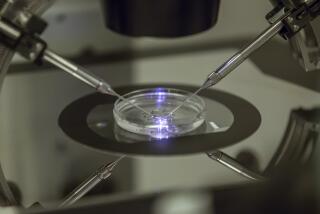Patients will pay for the crackdown on fetal tissue research, scientists fear

To save babies from brain-damaging birth defects, University of Pittsburgh scientist Carolyn Coyne studies placentas from fetuses that otherwise would be discarded — and she’s worried this kind of research may be on the way out.
The Trump administration is cracking down on fetal tissue research, with new hurdles for government-funded scientists around the country, who call the special cells vital for fighting a range of health threats. Already, the administration has shut down one university’s work using fetal tissue to test HIV treatments, and is ending other fetal tissue research at the National Institutes of Health.
“I knew this was something that’s going to trickle down to the rest of us,” said Coyne. She uses the placenta, which people may not think of as fetal tissue but technically is classified as such because the fetus produced it, to study how viruses such as Zika get past that protective barrier early in pregnancy.
“It seems to me what we’re moving toward is a ban,” she added. If so, when it comes to unraveling what happens in pregnancy and fetal development, “we’re going to stay ignorant to a lot of things.”
Different types of tissue left over from elective abortions have been used in scientific research for decades, and the work has been credited with leading to lifesaving vaccines and other advances. But on Wednesday, the Department of Health and Human Services abruptly announced the new restrictions on taxpayer-funded research under orders from President Trump. (Privately funded work was not affected.)
Aside from the cancellation of an HIV-related project at UC San Francisco, university-led projects that are funded by the NIH — estimated to be fewer than 200 — aren’t affected right away.
Bowing to anti-abortion lobby, Trump terminates crucial UCSF research contract »
However, as researchers seek to renew their funding or propose new studies, Health and Human Services said their proposals will have to pass an extra layer of review. In addition to the usual strict scientific scrutiny, each project will be considered by a federal ethics board that will recommend whether NIH should grant the money.
The agency hasn’t offered details, but under the law authorizing the review process, that board must include not just biomedical experts but a theologian. The nation’s health secretary can overrule its advice.
“I predict over time we will see a slow and steady elimination of federal funding for research that uses fetal tissue, regardless of how necessary it is,” said University of Wisconsin law professor R. Alta Charo, a nationally recognized bioethics expert.
Necessity is the crux of a fierce debate between abortion foes and scientists about whether there are alternatives to fetal tissue for research.
Zika offers a glimpse at the difficulty. Somehow, the Zika virus can sneak from the mother’s bloodstream across the placenta, which protects and nourishes the fetus, and target the fetus’ brain. Researchers hope to find a way to block that process.
Studying the placentas of small animals or even monkeys isn’t a substitute because they differ from the human organ, said Emory University researcher Mehul Suthar. For example, the specific type of placental cell where Zika can lurk in humans isn’t thought to be present in mouse placentas.
And because the placenta continually changes as the fetus that created it grows, first-trimester tissue may show a very different vulnerability than a placenta that’s expelled during full-term birth, when it’s no longer defined as fetal tissue but as medical waste.
Suthar recently submitted a new grant application to study first- and second-trimester placental tissue, and is worried about its fate under the still uncertain ethics provision.
It “sounds a bit murky as to what the impact could be,” he said. It could be small, “or it could be an outright ban on what we’re doing.”
Antiabortion groups argue that there are alternatives, such as stem cells, growing organ-like clumps of cells in lab dishes, or using tissue taken from newborns who undergo surgery.
Indeed, NIH is funding a $20-million program to research alternatives to fetal tissue and see whether they work as well.
“Taxpayer funding ought to go to promote alternatives that are already being used in the production of treatments, vaccines and medicines, and to expand approaches that do not depend on the destruction of unborn children,” said Mallory Quigley of the Susan B. Anthony List, which works to elect antiabortion candidates to public office.
But dozens of medical and science organizations have told the Department of Health and Human Services there is no substitute for fetal tissue in studying certain — not all — health disorders, such as HIV, Zika, Alzheimer’s, Parkinson’s, spinal cord injuries and a variety of eye diseases.
To Coyne, part of the political debate is a “completely unsubstantiated belief that not allowing research and science is going to prevent or stop abortions, which is not the case.”
Instead, research using fetal tissue will move to other countries, said Charo, who advised the Obama administration. The United Kingdom, Australia, Singapore and China are all using fetal tissue in their search for medical breakthroughs.
“Other countries work with this in a regulated fashion and they will continue to outstrip us,” she said. “We have allowed patients’ interests to become collateral damage in the abortion wars.”
Neergaard and Alonso-Zaldivar reported from Washington and Ritter reported from New York.






